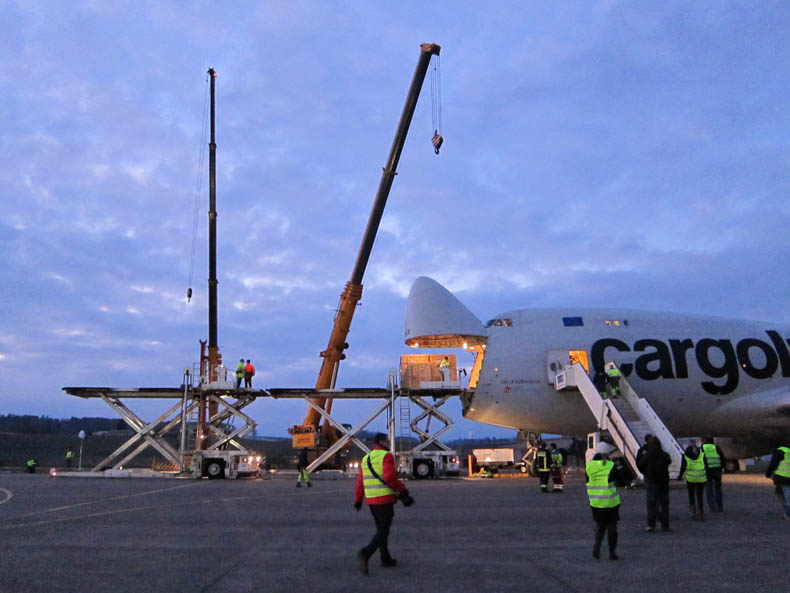
In the winter of 2013, I went on a not-very-successful reporting trip to Switzerland. I was writing about a solar airplane, the Solar Impulse, and got way less access to the project than I had expected.
But there was one highlight. After my odd tour of the hangar where the plane was being built, outside of Zurich, I caught a ride to the Payerne military airport, a couple of hours to the southwest, where the prototype of the plane, Solar Impulse HB-SIA, had been dismantled. The prototype had been put through a series of test flights. It proved that this crazy idea, a plane that flies using only the power of the sun, could actually work. When the test flights were over, the engineers figured it had just enough flying hours left in it to make a trip across the U.S., so the day after my visit, it was going to be flown to California.
The plane was definitely not up to the task of flying to California under its own power. It was going to travel in a Cargolux 747.
That’s Cargolux as in Luxembourg, not luxury, and Luxembourg was where the plane was flying in from. When the car pulled up, at 3 pm, people were lined up an artificial hill that paralleled the runway, waiting with their big cameras to capture the moment. The arrival of this plane was a major event for the local aviation enthusiasts. The last big aircraft to land there, the Solar Impulse PR person told me, was a C17 in 2007. So everyone who cared a lot about seeing odd planes on short runways had turned up.
The prototype solar plane hadn’t been designed to be dismantled. But the engineers had done all the measurements and used all their spatial reasoning and figured out precisely how it could be taken apart and packed into the belly of the cargo jet. Inside the hangar the delicate aircraft I’d heard so much about was on wheeled carts, with signs like “7 direction NOSE” indicating how each part would go into the plane.
Up close, it was clear how insubstantial the plane was. Its frame was made of carbon fiber, covered with a shiny, saran-wrap-like film so thin that I could have poked through it with my pen. (I was not tempted.) The plane can fly on solar power in part because it is so light. It has the wingspan of a 747, but only weighs as much as an SUV. The top surface of the wings is made up of solar cells. A lot of the weight is in the batteries.
We had a long wait for the cargo plane. I chatted with the communications team and a redheaded Canadian engineer. After we heard the plane had taken off, we wandered out to the hill. People around me chatted and joked in French, German, and English. At 5:25 the plane came into sight. I’d been told it would be exciting to see how the 747’s pilots would handle this short runway, but they didn’t need it. They showed off, braking to a stop long before the midpoint. The sun shone from the clouds in the west as the plane maneuvered into place outside the hangar.
After the assembled press and Solar Impulse team members checked out the inside of the cargo jet, the crew started loading the plane, very carefully. The pieces rode into the airplane on rollers, slowly, gently, one after another. A biting cold wind came up as the winter sun went down. At 7:30 I caught a ride back to Zurich with a carload of cheerful Solar Impulse workers.
The next day the plane inside a plane flew to California. The loading process was reversed, the plane was reassembled, and between May 3 and July 7 of 2013 it hopscotched its way across the U.S., flying for 14 to 21 hours at a time. After arriving in New York, the plane retired. Eventually my story about the Solar Impulse project came out in Discover. And in March 2015 the project’s two cofounders and pilots, Bertrand Piccard and André Borschberg, started alternating legs on a round-the-world trip, the first ever in a solar-powered plane.The trip was delayed for almost 10 months at one point, after the batteries were damaged by overheating.
So I was excited earlier this week when my phone whistled to tell me that the Solar Impulse was broadcasting a live video. The round-the-world trip was coming to an end. I watched as the Solar Impulse 2 descended through the night toward an Abu Dhabi runway, where it had set out more than a year ago. A local marching band was playing exotic music on drums and bagpipes. The plane touched down and ground crew members in reflective vests raced alongside it on bicycles. Piccard stuck his hand out of a tiny hole in the fusilage and clasped hands with Borschberg. “C’est formidable!” one of them said.
Formidable indeed. Nobody thinks passenger jets are about to fly on solar power alone—remember, Solar Impulse only weighs as much as an SUV—but, well, at least someone flew around the world on photons, once.
Photo: Helen Fields (that’s me)